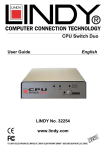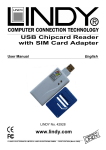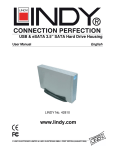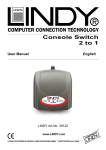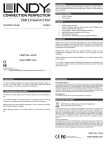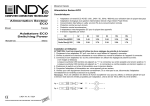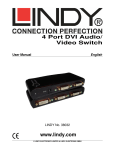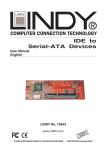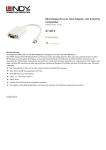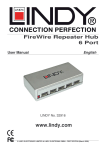Download Lindy 42339 Switch User Manual
Transcript
USB 2.0 4 Port Sharing Hub English User Manual LINDY No. 42887 www.LINDY.com © LINDY ELECTRONICS LIMITED & LINDY-ELEKTRONIK GMBH – SEC. EDITION - MARCH 2009 User Manual English Introduction Thank you for purchasing the LINDY USB 2.0 4 Port Sharing Hub! The LINDY USB 4 Port Sharing Hub provides you with an easy, cost-effective way to let two PC users co-use up to 4 peripheral devices, such as printers, scanners, card readers, pen drives, etc. Package Contents LINDY USB 2.0 4 Port Sharing Hub Power Supply User Manual Features Fully compliant with USB 2.0 and backwards compatible with USB 1.1 Provides 4 high-speed peripheral device ports and 2 PC host ports Supports 480/12/1.5 Mbps data transfer modes Supports Hot-swapping and plug and play Automatically select self or bus-power mode Over-current detection and protection on up-stream ports Supports Windows ME/2000/XP/Vista and Mac OS 8.6/9 or later Installation Using a USB Type A – USB Type B cable connect the first of your computers to Port A on the hub, then connect the second computer in the same way to port B. There is a slide switch on the hub which allows you to choose which PC has access to the USB hub, simply move the switch between A and B to switch between ports. You are now ready to start using the LINDY USB 4 Port Sharing Hub. The hub provides 5V DC, 500 mA power which is shared across all for ports, if you are using high power consumption USB peripherals, then it is recommended that you use the hub with the power supply attached. Using the supplied power supply the hub will provide 5V DC, 500 mA power on each of the four ports. Note If you are daisy chaining hubs, all hubs except the last one in the chain, the one farthest from the PC, must use a power supply; only the last hub in the chain may use Bus powered mode. Mode Powered Bus Power In to Unit Via a 5V 2A DC Power Adapter (Inner + , Outer -) From the PC’s USB Host Controller via the USB cable Power Out to Ports Each one of the unit’s four downstream ports is Supplied with DC +5V, 500mA (max) power All four downstream ports (in total) receive DC +5V, 500mA (max) power User Manual English Specification Specifications Downstream Ports Root Upstream 4 Ports LEDs Power Mode 2 1 Downstream Power Indicators Output Current 4 500mA max Operating Temperature 5 ~ 40°C Storage Temperature −20 ~ 60°C Humidity 0~80% RH Dimension (mm) 105 x 50 x 21 Casing Material Plastic Supported OS Windows ME/2000/XP/Vista Mac Mac OS 8.6/9 or later User Manual English Shielded cables must be used with this equipment to maintain compliance with radio frequency energy emission regulations and ensure a suitably high level of immunity to electromagnetic disturbances. FCC Warning This equipment has been tested and found to comply with the limits for a Class B digital device, pursuant to part 15 of the FCC Rules. These limits are designed to provide reasonable protection against harmful interference in a residential installation. This equipment generates, uses, and can radiate radio frequency energy and, if not installed and used in accordance with the instructions, may cause harmful interference to radio communications. However, there is no guarantee that interference will not occur in a particular installation. If this equipment does cause harmful interference to radio or television reception, which can be determined by turning the equipment off and on, the user is encouraged to try to correct the interference by one or more of the following measures: Reorient or relocate the receiving antenna Increase the separation between the equipment and receiver Connect the equipment into an outlet on a circuit different from that to which the receiver is connected Consult the dealer or an experienced technician for help You are cautioned that changes or modification not expressly approved by the party responsible for compliance could void your authority to operate the equipment. This device complies with part 15 of the FCC Rules. Operation is subject to the following two conditions: 1. This device may not cause harmful interference, and 2. This device must accept any interference received, including interference that may cause undesired operation. WEEE (Waste of Electrical and Electronic Equipment), Recycling of Electronic Products In 2006 the European Union introduced regulations (WEEE) for the collection and recycling of all waste electrical and electronic equipment. It is no longer allowable to simply throw away electrical and electronic equipment. Instead, these products must enter the recycling process. Each individual EU member state has implemented the WEEE regulations into national law in slightly different ways. Please follow your national law when you want to dispose of any electrical or electronic products. More details can be obtained from your national WEEE recycling agency. LINDY No 42887 2nd Edition, March 2009 www.lindy.com




